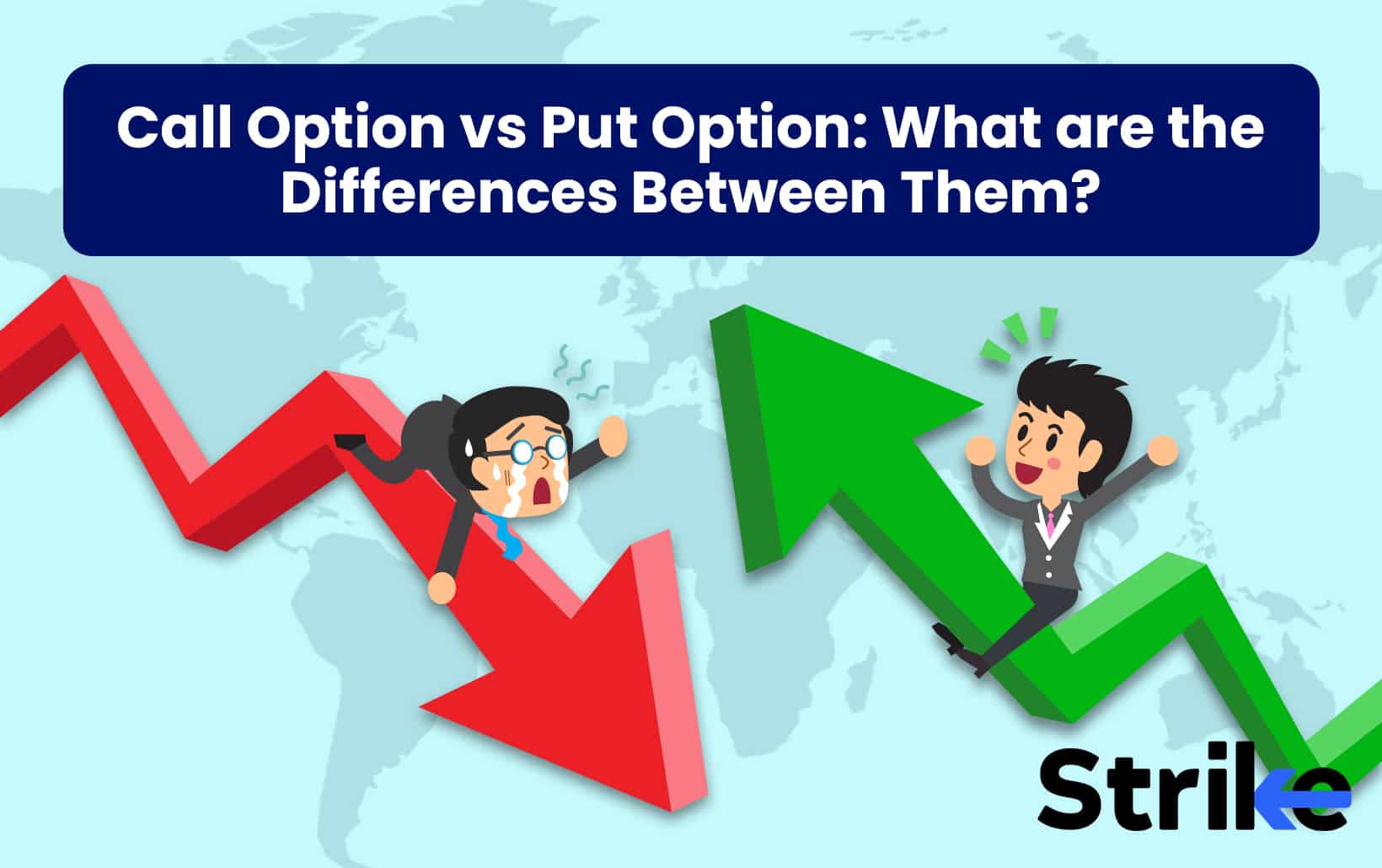
Call options and put options are instruments in options trading, offering investors different ways to speculate on or hedge against market movements. Call options and put options differ in their potential profit and loss profiles, with call buyers hoping for price increases and put buyers anticipating price declines in the underlying asset.
Call options give buyers the right to purchase an underlying asset at a predetermined price, while put options grant the right to sell at a specified price.
Buyers of call options profit when the underlying asset’s price rises above the strike price, whereas put option buyers benefit when the price falls below it. Call options are generally associated with bullish market sentiment, while put options are typically linked to bearish outlooks or used as a hedge against potential losses.
In 2023, call options made up about 60% of the total options traded on major exchanges, reflecting the bullish sentiment among investors, while put options accounted for 40%, often used for hedging purposes. This data is reported by major financial institutions and exchanges like the Chicago Board Options Exchange (Cboe) or market analytics firms like Options Clearing Corporation (OCC).
Key Differences Between Call and Put Options
The key differences between the call option and the put option are detailed in the comprehensive table below, which compares the two types of options across several dimensions.
| Feature | Call Option | Put Option |
| Definition | A call option gives the buyer the right, but not the obligation, to buy the underlying asset at a predetermined price (the strike price) on or before a specified date (the expiration date). | A put option gives the buyer the right, but not the obligation, to sell the underlying asset at a predetermined price (the strike price) on or before a specified date (the expiration date). |
| Buyer’s Motivation | A call buyer is bullish and believes the underlying asset’s price will rise above the strike price before expiration. | A put buyer is bearish and believes the underlying asset’s price will fall below the strike price before expiration. |
| Seller’s Obligation | The call seller is obligated to sell the underlying to the buyer at the strike price if it is assigned. | The put seller must buy the underlying from the buyer at the strike price if it is assigned. |
| Premium | The buyer pays an upfront premium to purchase the call option. A higher premium means the call option is more expensive to buy, | The buyer pays an upfront premium to purchase the put option. The higher the premium, the more expensive is to buy put option. |
| Break-even Point | Strike price + premium paid. The underlying price must rise above this for the call buyer to profit. | Strike price – premium paid. The underlying price must fall below this for the put buyer to profit. |
| Profit Potential | Unlimited profit potential as the underlying price rises. The call buyer exercises and acquires the asset below market value. | Maximum profit limited to the strike price. The put buyer exercises and sells the asset above market value. |
| Loss Potential | Maximum loss limited to the premium paid if the option expires worthless. | Unlimited loss potential if the underlying continues rising. The put buyer still has to pay the strike price. |
| Price Movement | Call premiums rise as the underlying asset’s price rises, and vice versa. | Put premiums rise as the underlying asset’s price falls, and vice versa. |
| Intrinsic Value | The amount by which the underlying price exceeds the strike price. The call is in-the-money. | The amount by which the strike price exceeds the underlying price. The put is in-the-money. |
| Time Value | Any extra premium representing the chance of profiting before expiration. Higher for longer-dated options. | Any extra premium representing the chance of profiting before expiration. Higher for longer-dated options. |
| Exercise | Only worthwhile to exercise if the underlying price exceeds the strike price. | Only worthwhile to exercise if the underlying price is below the strike price. |
| Expiration | Worthless and expires unexercised if the call option is out-of-the-money. | Worthless and expires unexercised if the put option is out-of-the-money. |
Here is an example of the difference between the call and put option. The charts are mirror images of each other. As the chart of calls is similar to the underlying asset, the chart of puts is totally opposite to the chart of calls; for reference, see the chart of the Banknifty 50000 Call Option below.
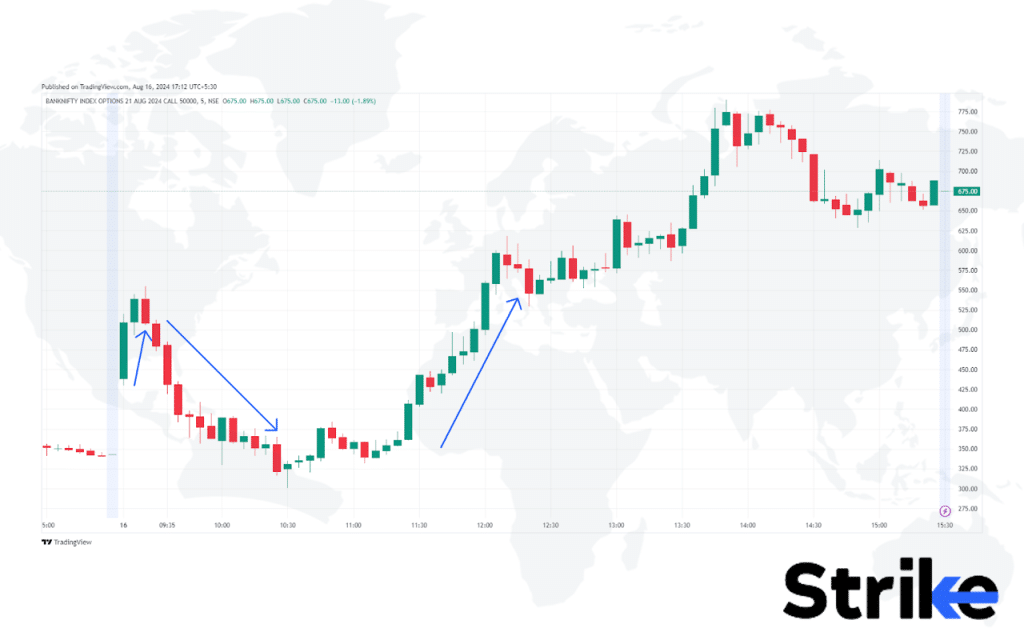
The chart below is of the Banknifty 50600 Put Option. Observe how the charts are opposite of each other. For example, the bullish candle on the calls chart is the bearish one on puts.
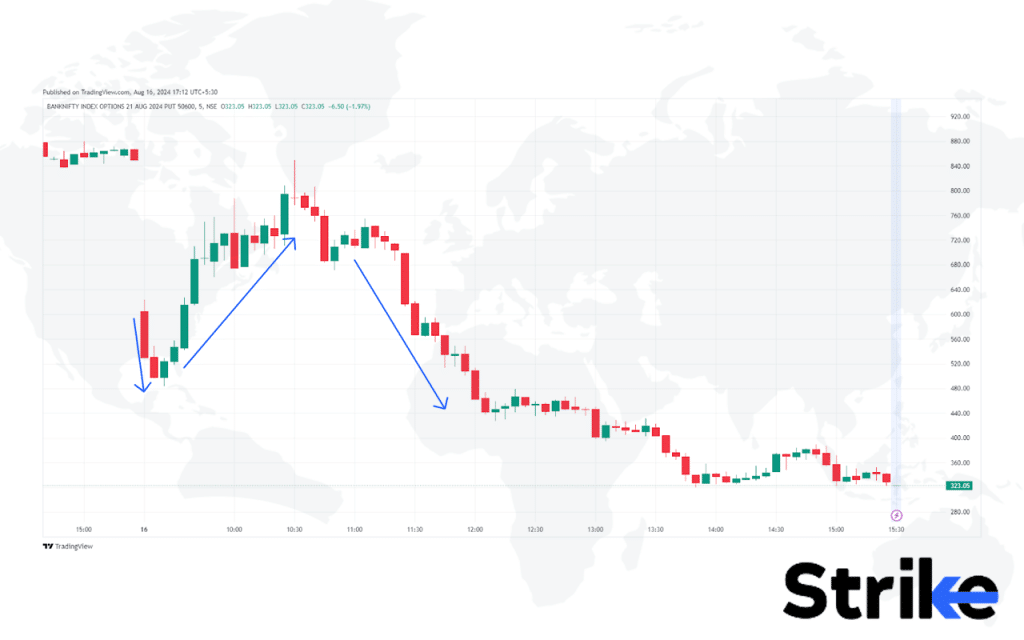
These two option variants exhibit stark contrasts in numerous dimensions, as call options permit the buying of the underlying asset, while put options permit the sale of it.
How is the Buying Call Option Different from the Buying Put Option?
The buying call option is different from the buying put option because buying a call gives the holder the right to buy the underlying asset at the strike price, whereas buying a put gives the holder the right to sell the underlying asset at the strike price. Investors buy call options with the expectation that the underlying asset’s price will rise above the strike price prior to expiration, thereby enabling them to acquire it at a lower price than the market. Likewise, purchasing a put option is a wager that the price will fall below the strike price, allowing the holder to sell the asset at the higher strike price. Look at the below image.
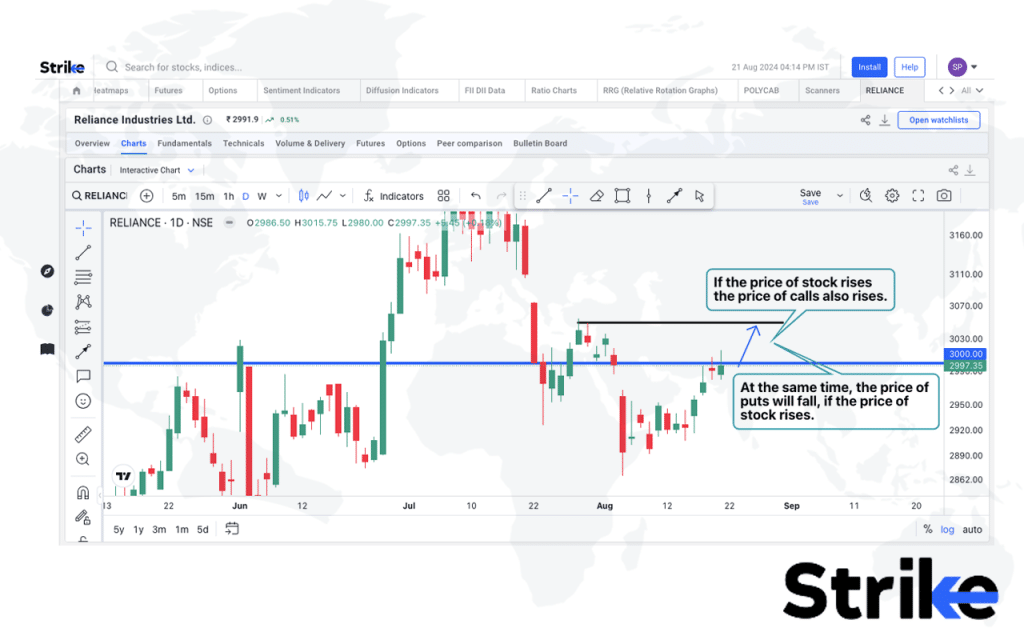
The current market price of RIL Ltd. is 3000. A Trader named ‘A’ who purchases a call option on Reliance Industries shares with a strike price of Rs. 3000. A Trader named ‘B’ who purchases a put option with a strike price of Rs. 3000 at the same time.
The price of the underlying asset, as in this case, RIL, rises to suppose 3050.
The call option becomes more valuable because it lets Trader ‘A’ buy the stock at Rs. 3000 while it’s worth Rs. 3050. Trader ‘A’ either may book the profit by selling the bought option at a higher price as the price of calls rise if the asset price rises.
Or he may exercise the option and buy the stock at Rs 3000 and sell it at Rs 3050 for a profit.
Trader ‘B’ bought 3000 PE when the market price was 3000, so,
The put option loses value because it allows Trader ‘B’ to sell the stock at Rs. 3000 while it’s worth Rs. 3050. Trader ‘B’ faces a loss since no one wants to sell at Rs. 3000 when they can sell at a higher market price.
How is the Writing Call Option Different from the Writing Put Option?
Writing a call option differs from writing a put option because the call option writer must sell the underlying asset at the strike price in the event of an exercise, whereas the put option writer must purchase the underlying asset at the strike price in the event of a put option exercise. The option writer receives the premium advance when writing a call, but they are exposed to upside risk if the asset price exceeds the strike price before expiration. However, the writer is exposed to downside risk when the asset price descends below the strike price when writing a put option.
Let’s break down an example to understand how writing a put option in action looks like on charts, as it is difficult to interpret reading the definition.
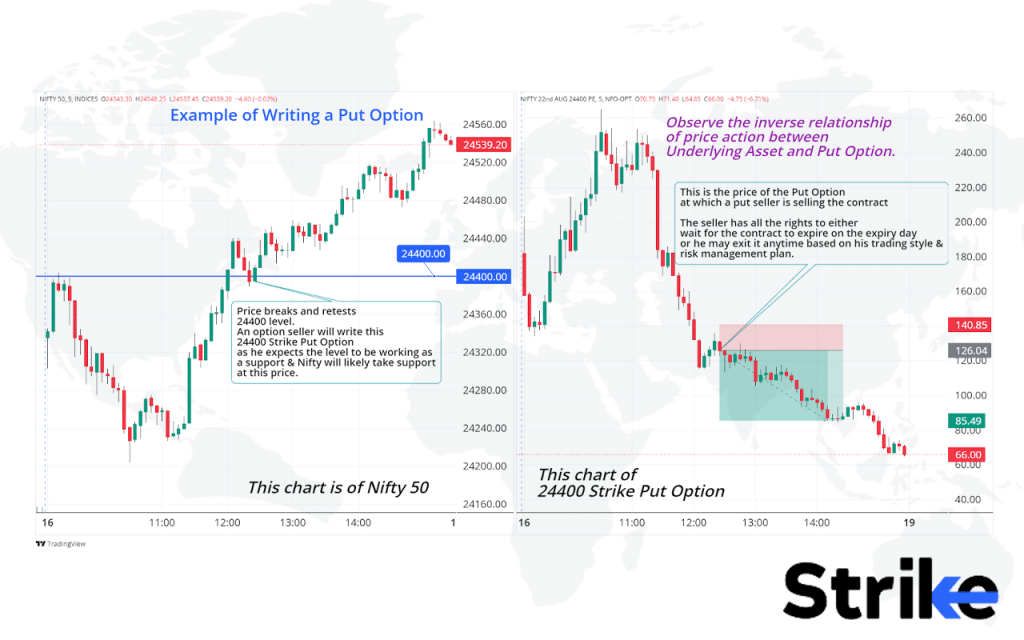
For example, an investor who writes a call option on Tata Motors shares with a strike price of Rs. 300 is obligated to sell Tata Motors shares at Rs.300 in the event that the option is exercised, regardless of whether the market price has increased to Rs. 350. However, option writing a put obligates the investor to buy Tata Motors shares at Rs.300 if the market price drops below that level.
When to Use Call Options?
Call options are suitable to use when an investor has a bullish outlook on a stock and wants to gain exposure with limited downside risk. Particularly, call option strategies enable the holder to acquire the underlying stock at the strike price if the stock price surpasses that threshold at the time of expiration. This gives the investor upside potential with the stock while limiting the maximum loss to the premium paid for the option.
According to the 2023 study “Derivatives and Market Strategies” conducted by the Institute of Financial Studies, the research indicated that investors using call options experienced a 20% average increase in returns compared to direct stock purchases due to the limited initial investment, which effectively leveraged bullish positions.
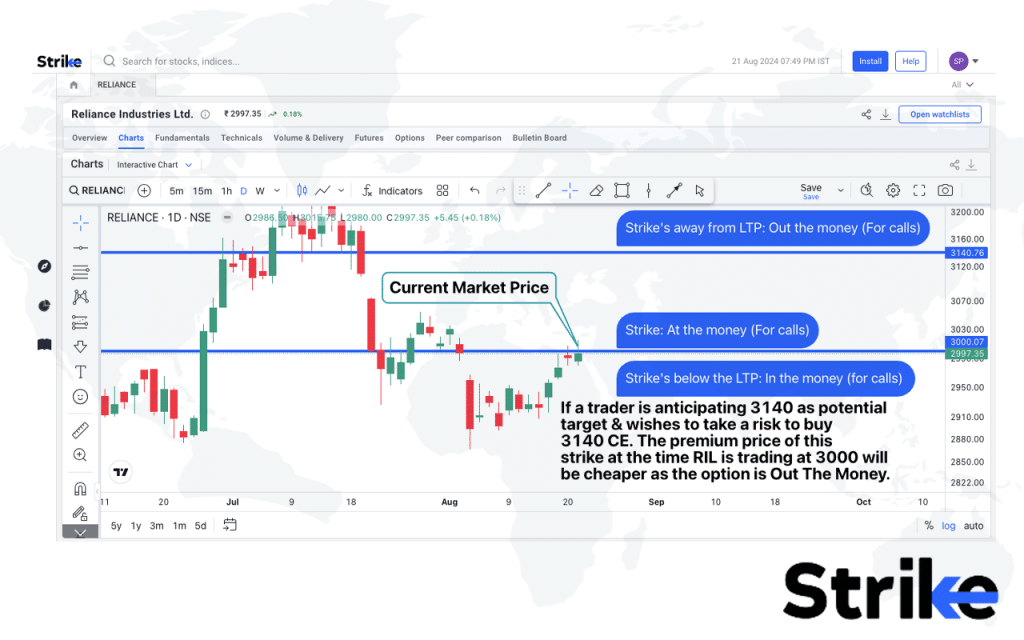
The current market price of RIL Ltd. is 3000 Rs. The trader is expecting reliance to become bullish and eventually reach 3140, which is his/her potential target.
Trader has his/her wish to buy 3140 CE for a supposing 20 rupee premium of next to next month’s expiry, suppose October’s expiry.
The maximum risk for this trader is 20 rupees per lot, meaning, if reliance fails to close above 3140 at the time of expiry (as in this case, October expiry), the premium of the option will likely decay and become worthless, i.e. zero.
The trader will experience profit if the share price of RIL increases above 3140. The premium bought at 20 will increase substantially if it crosses 3140 rapidly.
As the trader is expecting to be patient till the October expiry, if at all RIL keeps sustaining above 3140 till October, the premium will eventually become in the money and the premium will increase substantially, giving opportunity to the trader to exit from the profitable trade anytime.
When to Use Put Options?
Put options are suitable to use when an investor has a bearish outlook on a stock and wants to gain exposure with limited downside risk. In particular, put options allow the holder to sell the underlying stock at the strike price if it falls below that level on expiration. This safeguards the investor against a stock price decline, while also limiting the maximum loss to the option premium. Unlike short selling, which has theoretically unlimited risk, put options offer a more controlled way to profit from a bearish outlook.
A study titled “Options Strategies for Market Downturns,” conducted by the Financial Analysts Association in 2023, highlights that investors using put options effectively hedge against stock declines, with a reported 30% reduction in portfolio risk during market downturns.
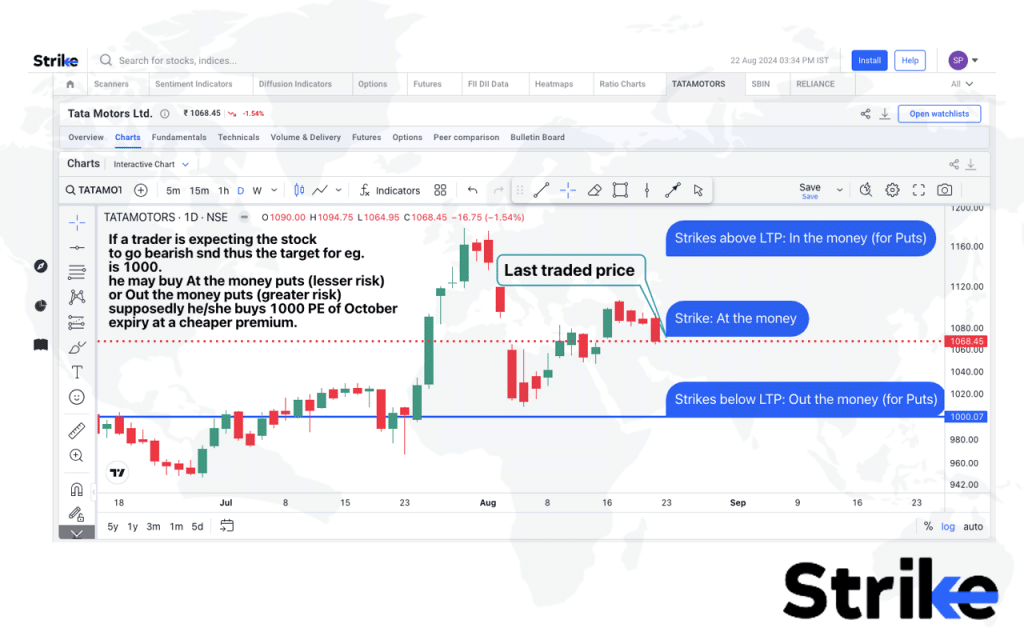
The current market price of TATA MOTORS Ltd. is 1068 Rs. The trader is expecting the stock to become bearish and eventually reach 1000, which is his/her potential target.
Trader has his/her wish to buy 1000 PE for 16 rupees premium of next to next month expiry, suppose October expiry.
The maximum risk for this trader is 16 rupees per lot, meaning suppose Tata Motors fails to close below 1000 at the time of expiry (as in this case, October expiry) the premium of the option will likely decay and become worthless, i.e., zero.
The trader will experience profit if the share price of the stock decreases below Rs.1,000. The premium bought at 16 will increase substantially if it crosses Rs. 1,000 rapidly.
As the trader is expecting to be patient till the October expiry, if at all Tata Motors keeps sustaining below 1000 till October, the premium will eventually become in the money and the premium will increase substantially, giving the trader to exit from the profitable trade anytime.
What are the Risks of Call vs Put Options?
The primary risk associated with the call vs. put option is that the call option seller/writer is susceptible to potentially unlimited losses in the event of a substantial increase in the underlying stock price, whereas the maximum loss for a call buyer is limited to the premium paid to buy the call option.
In case of puts, the maximum loss for the put option seller/writer is susceptible to potentially unlimited losses in the event of a substantial decrease in the underlying stock price, whereas the maximum loss for a put buyer is strictly limited to the premium paid to buy the call option.
According to the 2023 study “Options Risk Management and Market Trends” conducted by the Investment Strategies Institute, the research indicated that while call buyers could experience significant gains if the stock price exceeds the strike price, 40% of call options expire worthless which emphasised the need for careful market analysis given the 100% loss of the premium if the strike price is not exceeded.
In the event the stock price exceeds the strike price by a significant margin, the call purchased at a lower strike price will yield a substantial profit. However, the call will expire worthless if the stock price fails to exceed the strike price of the call option purchased.
The put buyer has the option to allow the option to expire worthless if the stock price exceeds the strike price at expiration, thereby limiting the maximum loss to the premium paid. However, the put buyer makes a profit if the stock declines below the strike price. Call buyers have potentially unlimited upside potential if the stock price rises significantly, but their downside risk is limited to the premium paid. Put buyers, on the other hand, have limited upside potential (up to the strike price) and limited downside risk (limited to the premium paid).
Which is More Profitable, Call or Put Option?
Call options are considered more profitable because they have unlimited gain potential. This is primarily because there is no upper limit on the price of a stock. Whereas put options’ profit potential is limited because a stock’s price won’t drop below zero.
The profitability of a call or put option depends on variables, including the stock’s price movement, time to expiration, implied volatility, and the trader’s ability to correctly predict market direction. Both calls and puts have the potential to be profitable or unprofitable depending on market conditions and the trader’s strategy. Factors like the option’s strike price, premium paid, and overall market trends also play crucial roles in determining an option’s profitability. Successful options trading requires careful analysis, risk management, and a thorough understanding of market dynamics rather than simply choosing between calls and puts.








![85 Common Stock Market Terminologies for Dummies [Updated List for 2026] 76 85 Common Stock Market Terminologies for Dummies [Updated List for 2025]](https://www.strike.money/wp-content/uploads/2025/04/Popular-Stock-Market-Terms-for-Beginners-Banner.png)










No Comments Yet.